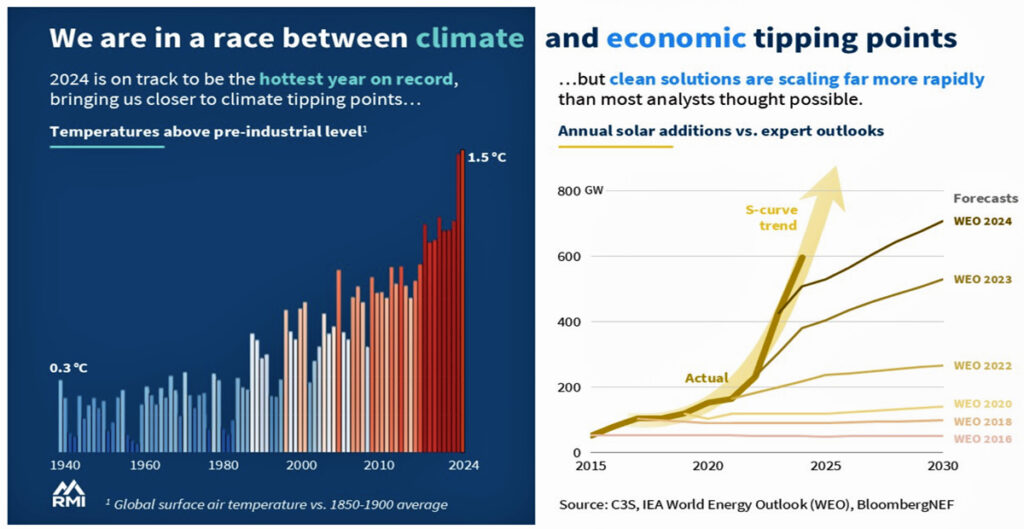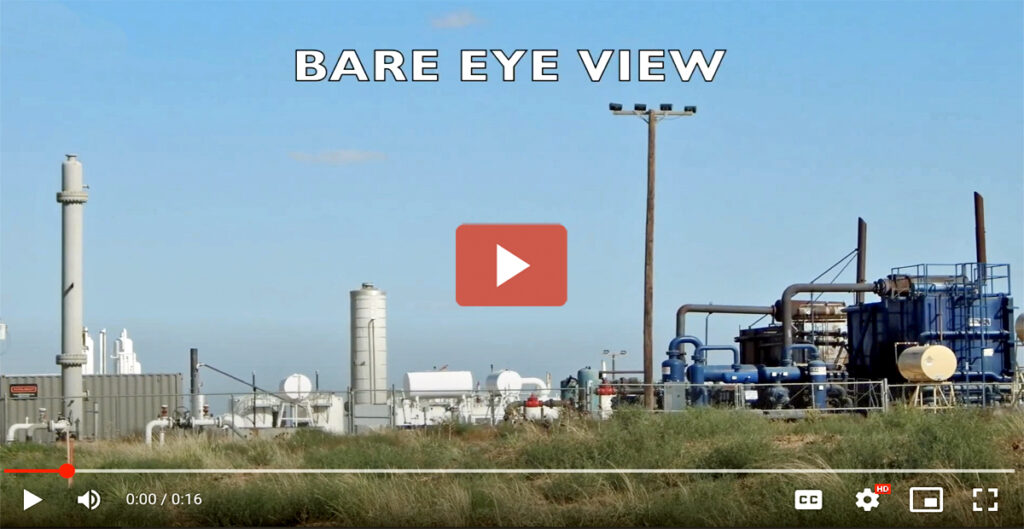Dear Friends,
The new year started with a bang. The heartbreaking and apocalyptic destruction of Los Angeles from a climate-enhanced winter wildfire juxtaposed against a new president who vows to increase production of fossil fuels, pulled the U.S. out of the Paris Agreement climate accord on day one, and has frozen federal funding supporting clean energy.
Unlike it did in 2016, the new administration does not deny that climate change exists. It simply does not deem the threat significant enough to override or influence other important policy goals, such as lowering inflationary pressure, marginalizing Russia’s geopolitical sway, increasing domestic manufacturing, and producing more energy to stabilize the grid. Calling fossil fuels the “gold beneath our feet” and dismissing the promise of clean energy to meet those policy objectives, President Trump clearly enunciated a direction that differs from the past four years, one that may seem seductive at first sight but is fraught in the long term.
The new administration’s actions won’t change economic reality: the costs of moving to a lower-carbon economy are much less than the costs of climate change’s damages. In almost every corner of the world, new power generation from renewable energy sources is much less expensive than from the lowest-cost fossil fuel provider (utility solar was 56% less expensive and wind was 67% cheaper on a global average for 2023). Innovation will disrupt legacy players even more, and the economic potential of the energy transition will only increase.
It’s going to be a wild ride as political aspirations and promises bump up against economic reality. There are conservative approaches to lessen the climate threat, but we need to start with a clear-eyed recognition of the problem. Stick with us as we guide you through the new challenges and opportunities ahead.
Sincerely,
The C-Change Conversations Team
Notable Quote
“Here is the reality: The very metabolism of the Earth has been thrown off by an atmosphere choking on greenhouse gasses, and it will take more than political bickering to set things right. Another reality: Fixing the problem first requires understanding – and, even more fundamentally, accepting – the science. Only then can we implement policies and put in place protocols that help us both reduce the likelihood of more such crises and minimize the death and destruction when they ultimately do occur.”
– Jeffrey Kluger, Time magazine
News of Concern
This month, NASA, NOAA, and other scientific organizations confirmed that 2024 was the hottest year on record with average global temperatures about 1.47°C above mid-19th century averages. Sea surface temperatures also broke heat records last year. This news, coupled with the inferno in California, was yet another wakeup call, fast on the heels of the supercharged hurricanes that wrought devastation in the fall. And while incidents like these may not necessarily be caused by climate change, they are usually “enhanced” by it – for example, foliage in the Los Angeles area was 25% drier due to climate change, enabling the fires to burn more quickly and ferociously. And Los Angeles’ destruction won’t be the last – three-fourths of the world has gotten drier due to climate change, which means one in three people live in “moisture-deprived areas” at risk not just of fire, but of drought, crop failure, and dust storms.
The personal and economic loss from the Los Angeles fires is yet another reminder that our insurance system is not built for such disasters. This article (published before the fires as well as before Hurricanes Helene and Milton) shows the magnitude of areas that are being underserved or dropped from coverage. Our once-great system that protected our homes and livelihoods no longer works – we’re building in places that we can’t afford to protect and our rates have become so high that many can’t afford policies (if they’re even available). To stay safe, we have to build safe, but costs are prohibitive and locations that are resistant to climate change are becoming scarcer.
There are even more troubling climate signals worldwide. Scientists who studied 2023’s high heat say it may have been caused in part by a decline in low clouds over the ocean, which lead to higher absorption of solar radiation. Recent satellite data shows that methane emissions (which trap 80 times more heat than CO2 in the short run) from landfills may be much higher than we thought. And whether we like it or not, what’s happening to polar bears and glaciers are a harbinger for all life on Earth as the Arctic heats up faster than any area of the world.
We know these hotter temperatures put our health at risk in the long term, but we’re also getting ill now. Flesh-eating bacteria [paywall] that thrive in the warm waters that come ashore during hurricanes. Increased food spoilage and food-borne illnesses. Unbreathable toxic wildfire smoke. The cost on our well-being – and on our wallets – is ratcheting up.
This heat is also dulling the spice in our lives – literally. Chili peppers are getting blander, as are coconuts and cabbage. And to be honest, we’re bitter about it – much like our coffee is tasting, too.
And even though we are creating more and more of our energy from renewable sources (you’ll read more below), the conundrum of how we meet our power demand while not increasing our fossil fuel usage remains, perhaps, the biggest challenge of our time. Off-the-charts power demand from AI, increased electrification, and climbing cooling needs are straining our grid to its breaking point.
At some point – and soon – something has to give.
News of Hope
While we are indeed looking at a bumpy road for a while, we also have positive news to keep us moving forward. Carbon-free energy made up 96% of new power on the U.S. grid in 2024. It’s remarkable progress … although, yes, it does come with an asterisk. Most of our electricity still comes from gas, and we used almost 4% more in 2024. But there’s a mind-boggling amount of renewable energy – 2.6 terawatts, or about double our grid’s current capacity – in the queue. If we can find a way to integrate enough of that clean energy, our system will become both more secure and economic.
While solar power remains king of the renewables, we’re ready to put our money on geothermal energy as second in command. The International Energy Agency (IEA) says geothermal has the next-highest clean power potential after solar, thanks to next-gen technologies that could harness heat from deeper inside the Earth. Scientists and business leaders alike are racing to make this vision – one that could provide 140 times the world’s current power demand – an economic and engineering reality.
Despite the current uncertainty about incentives for electric vehicles in the United States, sales were strong last year – and experts say they will likely remain so as battery costs continue to decrease, technology keeps improving, and new models that appeal to skeptics come onto the market. Other countries have embraced EVs in force – Bloomberg predicts EVs will make up 50% of the global market share by 2030 – and U.S. automakers do not intend to be left behind.
Even with a pin stuck in federal climate policies, states and cities have made big strides in lowering carbon emissions, and most have no plans to stop now. Case in point: Chicago, where all city municipal buildings – more than 400 of them – now run on 100% clean power. This transition is largely powered by solar and is predicted to reduce emissions equal to taking 62,000 cars off the road. Now that’s what we call driving change!
There’s also change afoot on the legal front. Earlier this month, the U.S. Supreme Court declined to hear an appeal by oil and gas companies to block a Hawaiian lawsuit that seeks billions for damages wrought by climate change disasters. It’s a vital precedent for future and impending legal proceedings. So is the decision of the Montana Supreme Court, which upheld a landmark case won by young climate activists who said state policies violated their right to a clean environment. Similar cases are on dockets in other states, including Florida, and around the world, as a younger generation raises its voices against policies and polluters that could put their future at risk.
Finally, let’s take just a moment to remind ourselves about the myriad, lower-tech ways that nature can help us reduce our carbon footprint. Consider bamboo – its forests absorb vast amounts of carbon and it can be used as fuel, building materials, and even food. Just imagine the potential of bamboo if, instead of fearing it as an invasive species as gardeners have been taught, we embrace its potential as an ally in lowering emissions. The possibilities could be endless – what a soothing thought.
Cimate Quiz
We had fun challenging ourselves with this short New York Times quiz about climate costs and impacts. Take a minute to test yourself!
Notable Graph

Here it is in color – temperatures are rising fast, but so are the solutions that not only can mitigate our risks, but can reap economic benefits as well. We’ll be watching closely in 2025 and hoping cool heads prevail.
Notable Video
What if we could see emissions polluting the air? Would we care more? Take a look at a typical natural gas venting episode in Florida. Infrared optical gas imaging captures what our naked eyes can not.



